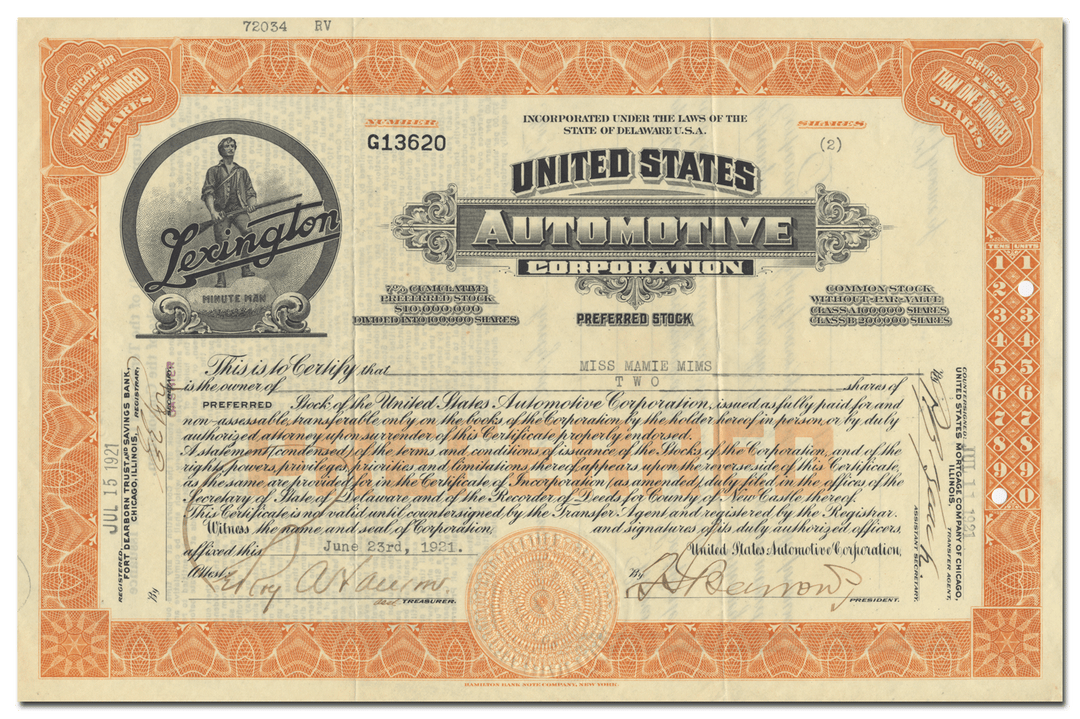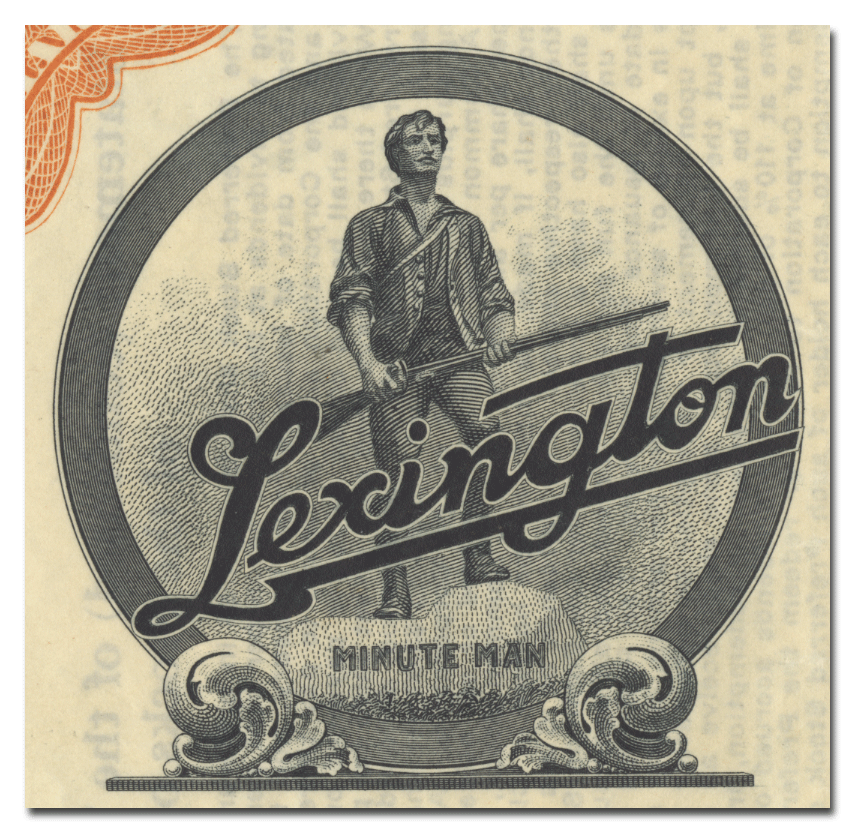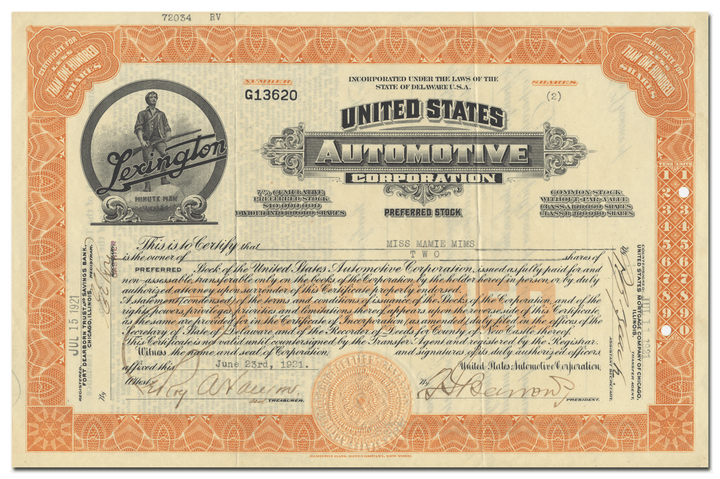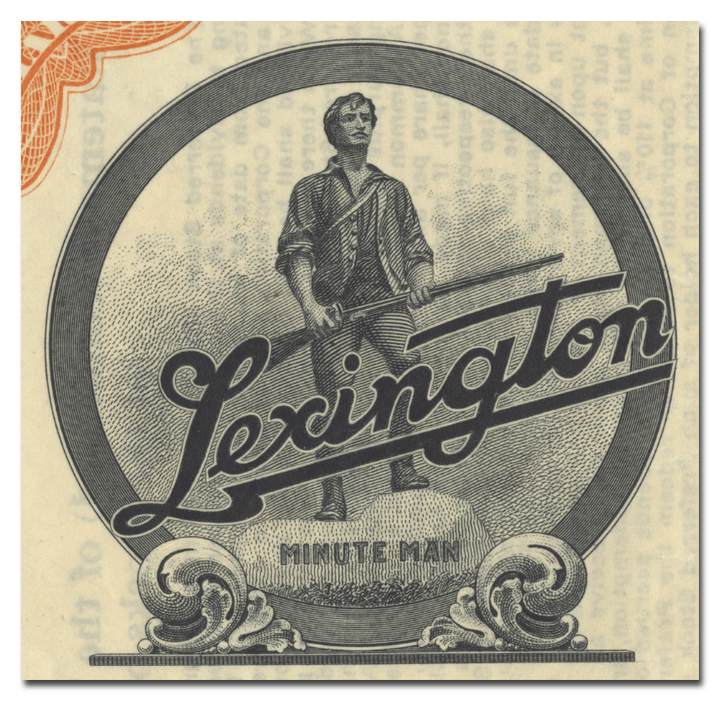United States Automotive Corporation (Lexington)
- Guaranteed authentic document
- Orders over $75 ship FREE to U. S. addresses
Product Details
CompanyUnited States Automotive Corporation
Certificate Type
Preferred Stock
Date Issued
June 23, 1921
Canceled
No
Printer
Hamilton Bank Note Company
Signatures
Hand signed
Approximate Size
12" (w) by 8" (h)
Images
Show the exact certificate you will receive
Guaranteed Authentic
Yes
Additional Details
NA
Historical Context
The Lexington Motor Company was founded in 1909 in Lexington, Kentucky, by Kinzea Stone, a Kentucky race horse promoter from Georgetown, Kentucky. Several months later, the company outgrew its building.
In 1910, a group of Connersville businessmen noted the community had too much tied up in the buggy and carriage industry, which was being displaced by the growing use of the automobile. The group enticed the infant Lexington Motor Car Company to relocate from Lexington to a new plant at 800 West 18th Street in the McFarlan industrial park, with headquarters at 1950 Columbia Avenue. John C. Moore, the company's chief engineer, immediately started on improvements to the Lexington to keep the company ahead of its competition. His 1911 multiple exhaust was reported to give 30 percent more power on less fuel. Each cylinder had a separate exhaust. Dual exhaust pipes and mufflers were used.
The company entered both the Glidden Tour and Indianapolis 500 in 1912.
Acquisition and Expansion
Financial difficulties were solved in 1913 when E.W. Ansted acquired Lexington to assemble the six-cylinder Howard for a contract with a Chicago distributor. The resultant company was named Lexington-Howard. In 1915, the name changed back to Lexington Motor Company. The regular four-cylinder engine was supplemented by a light six and a supreme six. With the new Ansted engines, its cars became modern and powerful. In 1916, Lexington was using the Continental engine.
Lexington's first plant expansion was in 1915. A factory building was erected just north of the office. Also built at the same time was a 100-foot smokestack with the Lexington name in lighter color bricks. Four years later the company built a 106,050 sq ft assembly building just west of the office.
In 1917, Moore put together a new frame with a rigid box cross-section that eliminated the problem of jammed doors caused by frame flexing. This car also had an emergency brake affixed to the drive shaft. In 1918, Lexington autos featured hardtop enclosures made by the Rex Manufacturing Company, also of Connersville.
Also in 1918, the newly formed Ansted Engineering Company acquired Teetor-Harley Motor Corporation of Hagerstown, Indiana. In 1919, the 85,306 sq ft Ansted Engine building was erected just north of the Lexington plant and extended to 21st Street. The combined Lexington and Ansted facilities measured three blocks long and two blocks wide totaling 270,000 sq ft of floor space.
Heyday
Two short-wheelbase race cars with the powerful Ansted engine were built by Lexington for the 1920 Pikes Peak hill climb. The cars placed first and second in their initial outing and brought home the Penrose trophy. Again in 1924, Otto Loesche won, with an 18-minute 15 second dash and brought the trophy home for keeps. The Penrose trophy is on display at the Fayette County Historical Museum on Vine Street, Connersville Indiana.

The formation of the United States Automotive Corporation was announced by President Frank B. Ansted at the New York Auto Show on January 12, 1920. It was a $10 million merger with the Lexington, the Ansted Engineering Company, and Connersville Foundry Corporation, all from Connersville, plus the Teetor-Harley Motor Corporation of Hagerstown. 1920 marked the high point of Lexington production with over 6,000 built.
On December 16, 1921, William C. Durant, founder of General Motors and former GM president, ordered 30,000 Ansted engines for his new Durant Six, being built in Muncie, Indiana, by Durant Motors, Inc. Late in 1921, Alanson P. Brush (designer of the Brush Runabout and consulting engineer to General Motors) sued the company, alleging the Ansted engine infringed a number of his patents. The negative publicity hurt.
Records show in 1922, United States Automotive Corporation, Lexington's parent company, owned ten different factories building parts for its cars. Auto historian Henry Blommel notes, "It was a great alliance of parts-making plants that found the culmination of its efforts in the finished Lexington car."
Phaseout
The post-World War I recession of the early twenties destroyed many American automobile manufacturers. Lexington Motor Car Company and United States Automotive Corporation were affected by these recessionary events. Production in 1922 plummeted to roughly a third of that of 1920. In 1923, Ansted Engine Company entered receivership, with Durant as a principal shareholder. Lexington also entered receivership in 1923. In 1926 and 1927, respectively, E.L. Cord's Auburn Automobile Company purchased Ansted Engine and the Lexington Motor Car Company. The Lexington was soon phased out.
Related Collections
Additional Information
Certificates carry no value on any of today's financial indexes and no transfer of ownership is implied. All items offered are collectible in nature only. So, you can frame them, but you can't cash them in!
All of our pieces are original - we do not sell reproductions. If you ever find out that one of our pieces is not authentic, you may return it for a full refund of the purchase price and any associated shipping charges.









